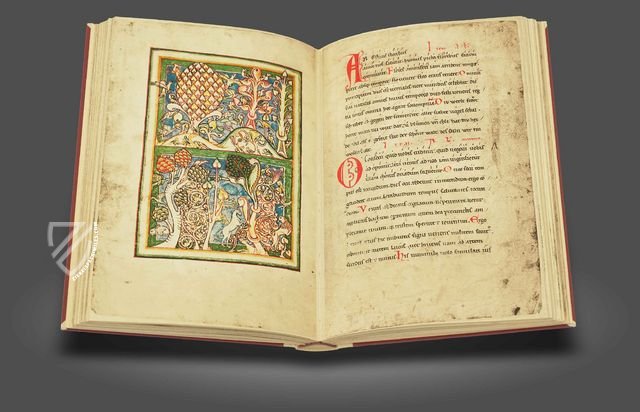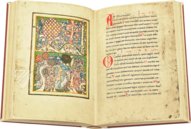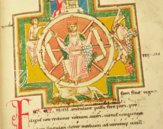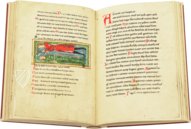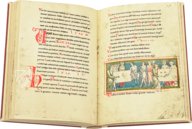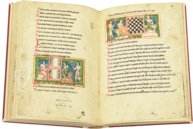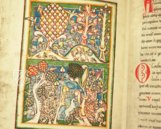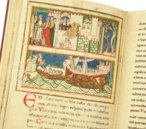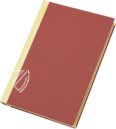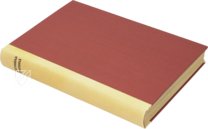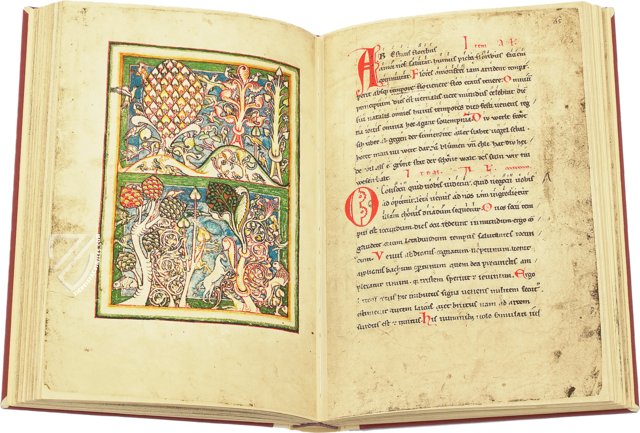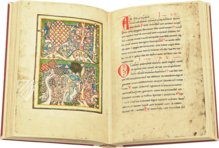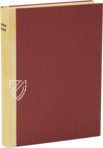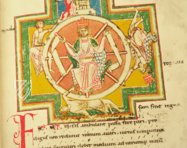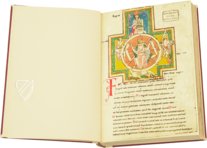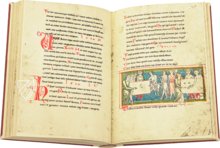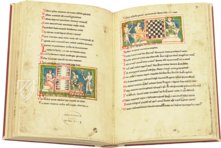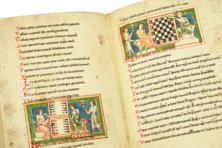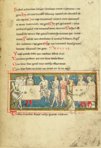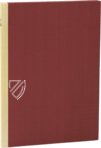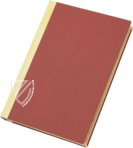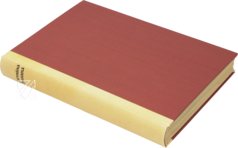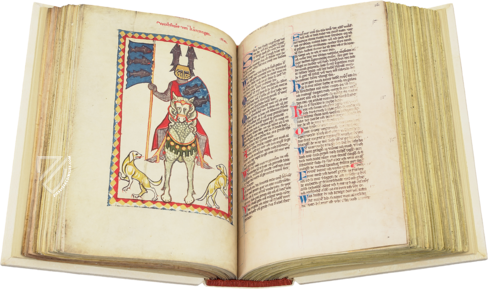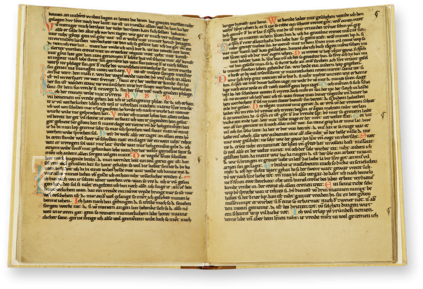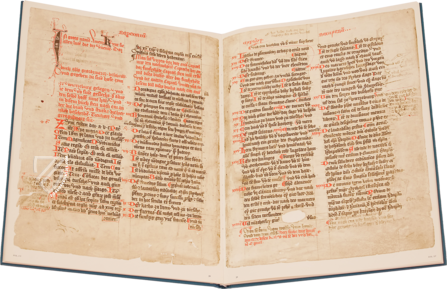Carmina Burana + Fragmenta Burana
(1,000€ - 3,000€)
The manuscript of the Carmina Burana is a unique testimonial to the literature and music of the Middle Ages. In a spectacular find, Johann Christoph von Aretin discovered this manuscript in Benediktbeuern Abbey during the course of Secularization. The manuscript, which was begun in the 13th century and was continued until the second half of the 14th century, contains a true treasure: 318 texts, which only survive here for the most part, of lyrics, songs, and dramas by the most important poets of their time! As an additional idiosyncrasy, the texts of this famous song manuscript are illustrated with wonderful miniatures. The famous Beurer Songs, an all-around exceptional manuscript!
Carmina Burana + Fragmenta Burana
The manuscript of the Carmina Burana is a unique testimonial to the literature and music of the Middle Ages. In a spectacular find, Johann Christoph von Aretin discovered this manuscript in Benediktbeuern Abbey during the course of Secularization. The manuscript, which was begun in the 13th century and was continued until the second half of the 14th century, contains a true treasure: 318 texts of lyrics, songs, and dramas by the most important poets of their time, which only survive here for the most part! As an additional idiosyncrasy, the texts of this famous song manuscript are illustrated with wonderful miniatures. The famous Beurer Songs, an all-around exceptional manuscript!
The Famous Beurer Songs
Just about everyone can recall the monumental sounds with which Carl Orff reset the Carmina Burana to music in 1935/6. The Beurer Songs, better known under the Latin term Carmina Burana, are counted among mankind’s cultural heritage. Yet, they were lost until the early 19th century. The unique manuscript first reappeared in the course of secularization: by means of the 1803 discovery by Johann Christoph von Aretin in the library of the Benediktbeuern Abbey.
A Song Manuscript from the Alps
Having said this, the Upper-Bavarian Benediktbeuern Abbey is not the song manuscript’s point of origin. The Carmina Burana presumably came from Carinthia, Styria, or modern South Tirol. The manuscript was begun around 1230, but was continuously appended through the second half of the 14th century. Aside from the literary-musical text, the illustrations accompanying the text are also unique. Such wonderful pictorial décor is extremely unusual for a song manuscript. Depictions both small and large, some even full-page, show e.g. various board games (backgammon, chess, etc.), but also biblical and historical events. The marvelous miniature of the wheel of fortune in a circular depiction is also well-known.
Unique Testimonies to Medieval Music and Literature
Yet, the real treasure of the manuscript lays in its textual content, which also lends it its name, the Beurer Songs. This “unique anthology of musical and dramatic texts from the 11th and 12th centuries” contains the most important collection of medieval itinerant music. Alongside Latin secular lyrics, the Middle High German lyrics of the early 13th century are represented in moralizing-satirical poems, love songs, drinking songs, playful songs, and sacred plays. The 318 texts altogether, which have largely survived, even though they have been transmitted anonymously, can nonetheless be ascribed to a few famous poets. Some famous names are represented, here with Walther von der Vogelweide, Otto von Botenlauben, and Neidhardt among them.
A Gem of the Bavarian State Library
The Carmina Burana have only survived in a single manuscript, additionally, a fragment has been preserved. Both manuscripts are stored today under the shelf marks Clm 4660 and Clm 4660a in the Bayerische Staatsbibliothek in Munich. The famous manuscript of the Beurer Songs allows the beholder to immerse themselves in the world of the Middle Ages and its great poets.
Codicology
- Alternative Titles
- Carmina Burana aus Benediktbeuren
Codex Buranus mit Fragment - Size / Format
- 224 pages / 25.0 × 17.0 cm
- Origin
- Austria
- Date
- Around 1230–14th century
- Style
- Genre
- Script
- German Gothic
- Illustrations
- framed miniatures
numerous lombards
many letter bodies decorated with distinctive faces
pen drawings - Artist / School
- Walther von der Vogelweide (1170–1230), Otto von Botenlauben or Botenlouben (1177–1245) and others (authors)
- Previous Owners
- Benediktbeuern Abbey
Carmina Burana + Fragmenta Burana
Chess Players
Two noblemen are seated in arm chairs and playing a game of chess as a poised attendant standing on his toes brings a chalice full of wine to the player dressed in yellow on the left. His garments are outlined in red to accentuate the fall of folds. It is still early in the game and the player dressed in green on the right appears to be moving his rook. He is wearing a cap with a chin strap while the two figures on the left are depicted with flowing brown hair.

Carmina Burana + Fragmenta Burana
Wheel of Fortune
The Wheel of Fortune was a common theme in the philosophy of antiquity and the Middle Ages, which symbolized the fickle nature of fate. It is the prerogative of the goddess Fortuna to spin the wheel at random for the benefit of some and the detriment of others. The figures in this depiction are labelled (clockwise from the top) Regno, Regnavi, Sum sine regno, Regnabo, “I reign, I reigned, My reign is finished, I shall reign”.
Fortuna is depicted holding two blanks scrolls, symbolic of the yet-unwritten events of the future, before an eight-spoke wagon wheel. Always depicted as a woman, the deity was a common medieval allegory for the temporality of earthly things, often focusing on the downfall of the powerful.

#1 Carmina Burana
Language: German
(1,000€ - 3,000€)
- Treatises / Secular Books
- Apocalypses / Beatus
- Astronomy / Astrology
- Bestiaries
- Bibles / Gospels
- Chronicles / History / Law
- Geography / Maps
- Saints' Lives
- Islam / Oriental
- Judaism / Hebrew
- Single Leaf Collections
- Leonardo da Vinci
- Literature / Poetry
- Liturgical Manuscripts
- Medicine / Botany / Alchemy
- Music
- Mythology / Prophecies
- Psalters
- Other Religious Books
- Games / Hunting
- Private Devotion Books
- Other Genres
- Afghanistan
- Armenia
- Austria
- Belgium
- Colombia
- Croatia
- Cyprus
- Czech Republic
- Denmark
- Egypt
- Ethiopia
- France
- Germany
- Greece
- Hungary
- India
- Iran
- Iraq
- Israel
- Italy
- Japan
- Lebanon
- Luxembourg
- Mexico
- Morocco
- Netherlands
- Palestine
- Peru
- Poland
- Portugal
- Russia
- Serbia
- Spain
- Sri Lanka
- Sweden
- Switzerland
- Syria
- Turkey
- Ukraine
- United Kingdom
- United States
- Uzbekistan
- Aboca Museum
- Ajuntament de Valencia
- Akademie Verlag
- Akademische Druck- u. Verlagsanstalt (ADEVA)
- Aldo Ausilio Editore - Bottega d’Erasmo
- Alecto Historical Editions
- Alkuin Verlag
- Almqvist & Wiksell
- Amilcare Pizzi
- Andreas & Andreas Verlagsbuchhandlung
- Archa 90
- Archiv Verlag
- Archivi Edizioni
- Arnold Verlag
- ARS
- Ars Magna
- ArtCodex
- AyN Ediciones
- Azimuth Editions
- Badenia Verlag
- Bärenreiter-Verlag
- Belser Verlag
- Belser Verlag / WK Wertkontor
- Benziger Verlag
- Bernardinum Wydawnictwo
- BiblioGemma
- Biblioteca Apostolica Vaticana (Vaticanstadt, Vaticanstadt)
- Bibliotheca Palatina Faksimile Verlag
- Bibliotheca Rara
- Boydell & Brewer
- Bramante Edizioni
- Bredius Genootschap
- Brepols Publishers
- British Library
- C. Weckesser
- Caixa Catalunya
- Canesi
- CAPSA, Ars Scriptoria
- Caratzas Brothers, Publishers
- Carus Verlag
- Casamassima Libri
- Chavane Verlag
- Christian Brandstätter Verlag
- Circulo Cientifico
- Club Bibliófilo Versol
- Club du Livre
- CM Editores
- Collegium Graphicum
- Collezione Apocrifa Da Vinci
- Comissão Nacional para as Comemorações dos Descobrimentos Portugueses
- Coron Verlag
- Corvina
- CTHS
- D. S. Brewer
- Damon
- De Agostini/UTET
- De Nederlandsche Boekhandel
- De Schutter
- Deuschle & Stemmle
- Deutscher Verlag für Kunstwissenschaft
- DIAMM
- Droz
- E. Schreiber Graphische Kunstanstalten
- Ediciones Boreal
- Ediciones Grial
- Ediclube
- Edições Inapa
- Edilan
- Editalia
- Edition Deuschle
- Edition Georg Popp
- Edition Leipzig
- Edition Libri Illustri
- Editiones Reales Sitios S. L.
- Éditions de l'Oiseau Lyre
- Editions Medicina Rara
- Editorial Casariego
- Editorial Mintzoa
- Editrice Antenore
- Editrice Velar
- Edizioni Edison
- Egeria, S.L.
- Eikon Editores
- Electa
- Emery Walker Limited
- Enciclopèdia Catalana
- Eos-Verlag
- Ephesus Publishing
- Ernst Battenberg
- Eugrammia Press
- Extraordinary Editions
- Fackelverlag
- Facsimila Art & Edition
- Facsimile Editions Ltd.
- Facsimilia Art & Edition Ebert KG
- Faksimile Verlag
- Feuermann Verlag
- Folger Shakespeare Library
- Franco Cosimo Panini Editore
- Friedrich Wittig Verlag
- Fundación Hullera Vasco-Leonesa
- G. Braziller
- Gabriele Mazzotta Editore
- Gebr. Mann Verlag
- Gesellschaft für graphische Industrie
- Getty Research Institute
- Giovanni Domenico de Rossi
- Giunti Editore
- Graffiti
- Grafica European Center of Fine Arts
- Guido Pressler
- Guillermo Blazquez
- Gustav Kiepenheuer
- H. N. Abrams
- Harrassowitz
- Helikon
- Hendrickson Publishers
- Henning Oppermann
- Herder Verlag
- Hes & De Graaf Publishers
- Hoepli
- Holbein-Verlag
- Hortus Deliciarum
- Houghton Library
- Hugo Schmidt Verlag
- Idion Verlag
- Il Bulino, edizioni d'arte
- ILte
- Imago
- Insel Verlag
- Instituto Nacional de Antropología e Historia
- Istituto dell'Enciclopedia Italiana - Treccani
- Istituto Ellenico di Studi Bizantini e Postbizantini
- Istituto Geografico De Agostini
- Istituto Poligrafico e Zecca dello Stato
- Italarte Art Establishments
- J. Thorbecke
- Jan Thorbecke Verlag
- Johnson Reprint Corporation
- Josef Stocker
- Josef Stocker-Schmid
- Jugoslavija
- Karl W. Hiersemann
- Kasper Straube
- Kaydeda Ediciones
- Kindler Verlag / Coron Verlag
- Kodansha International Ltd.
- Konrad Kölbl Verlag
- Kurt Wolff Verlag
- La Liberia dello Stato
- La Linea Editrice
- La Meta Editore
- Lambert Schneider
- Landeskreditbank Baden-Württemberg
- Leo S. Olschki
- Les Incunables
- Library of Congress
- Libreria Musicale Italiana
- Lichtdruck
- Lito Immagine Editore
- Lumen Artis
- Lund Humphries
- M. Moleiro Editor
- Maison des Sciences de l'homme et de la société de Poitiers
- Manuscriptum
- Martinus Nijhoff
- Maruzen-Yushodo Co. Ltd.
- MASA
- McGraw-Hill
- Militos
- Millennium Liber
- Müller & Schindler
- Nahar and Steimatzky
- National Library of Wales
- Neri Pozza
- Nova Charta
- Oceanum Verlag
- Odeon
- Orbis Mediaevalis
- Orbis Pictus
- Österreichische Staatsdruckerei
- Oxford University Press
- Pageant Books
- Parzellers Buchverlag
- Patrimonio Ediciones
- Pattloch Verlag
- PIAF
- Pieper Verlag
- Plon-Nourrit et cie
- Prestel Verlag
- Princeton University Press
- Prisma Verlag
- Priuli & Verlucca, editori
- Pro Sport Verlag
- Propyläen Verlag
- Pytheas Books
- Quaternio Verlag Luzern
- Reales Sitios
- Recht-Verlag
- Reichert Verlag
- Reichsdruckerei
- Riehn & Reusch
- Roberto Vattori Editore
- Rosenkilde and Bagger
- Roxburghe Club
- Salerno Editrice
- Sarajevo Svjetlost
- Schöck ArtPrint Kft.
- Scolar Press
- Scrinium
- Scripta Maneant
- Scriptorium
- Siloé, arte y bibliofilia
- SISMEL - Edizioni del Galluzzo
- Sociedad Mexicana de Antropología
- Société des Bibliophiles & Iconophiles de Belgique
- Soncin Publishing
- Sorli Ediciones
- Stainer and Bell
- Studer
- Styria Verlag
- Sumptibus Pragopress
- Szegedi Tudomànyegyetem
- Taberna Libraria
- Tarshish Books
- Taschen
- Tempus Libri
- Testimonio Compañía Editorial
- Thames and Hudson
- The Clear Vue Publishing Partnership Limited
- The Facsimile Codex
- The Folio Society
- The Marquess of Normanby
- The Richard III and Yorkist History Trust
- Tip.Le.Co
- TouchArt
- TREC Publishing House
- TRI Publishing Co.
- Trident Editore
- Typis Regiae Officinae Polygraphicae
- Union Verlag Berlin
- Universidad de Granada
- University of California Press
- University of Chicago Press
- Urs Graf
- Vallecchi
- Van Wijnen
- VCH, Acta Humaniora
- VDI Verlag
- VEB Deutscher Verlag für Musik
- Verlag Anton Pustet / Andreas Verlag
- Verlag Bibliophile Drucke Josef Stocker
- Verlag der Münchner Drucke
- Verlag für Regionalgeschichte
- Verlag Styria
- Vicent Garcia Editores
- W. Turnowsky
- Waanders Printers
- Wiener Mechitharisten-Congregation (Wien, Österreich)
- Wissenschaftliche Buchgesellschaft
- Wydawnictwo Dolnoslaskie
- Xuntanza Editorial
- Zakład Narodowy
- Zollikofer AG

